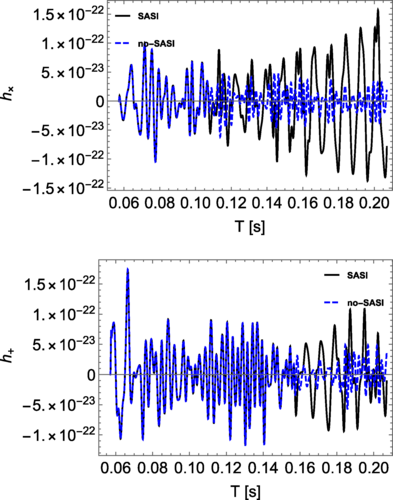Characterizing a supernova’s standing accretion shock instability with neutrinos and gravitational waves: Zidu Lin, Abhinav Rijal, Cecilia Lunardini, Manuel D. Morales, and Michele Zanolin
Phys. Rev. D 107 (2023) 083017Our work is inspired by the fact that both neutrino and GW signals are sensitive to the properties of CCSNe matter in the inner region of the star. Given the huge progress made in detection technologies in both neutrino and GW channels, it is very likely that the next galactic CCSN will be observed by our next-generation neutrino as well as GW telescopes with unprecedented details. Consequently, it is natural to ask: what physics about a CCSN can be learnt by jointly analyzing the neutrino and the GW signals from this dying massive star?
This paper proposes a multi-messenger approach for studying supernovae. The galactic CCSNe events are rare, and it is almost an obligation that we extract the astrophysical information as much as we can from a future observation of galactic CCSN. The multi-messenger approaches can help us to better achieve this goal. Briefly speaking, in this work we propose a method that can help scientists to understand a complex hydrodynamical phenomenon, the Standing Accretion Shock Instability (SASI), in a more comprehensive way by jointly analyzing future neutrino and GW signals from CCSNe.
There are still many unclear physics aspects about the inner region of CCSNe. For example, the descriptions of hydrodynamics, neutrino transport, and properties of dense matter in CCSNe are all highly model-dependent. However, there are currently only a few observables that we can use to verify our theories about CCSNe. The traditional single-messenger method may not be powerful enough to test these theories. One specific example is the relationship between the frequency of the SASI in the neutrino signal and the GW signal. A multi-messenger analysis might lift the "degeneracy" of CCSNe models and can help us to more efficiently validate the prediction of SASI activity against future neutrino and GW signals. The method we propose might be one of a few multi-messenger approaches that can quantitatively analyze the features of the predicted SASI activity in CCSNe. What's more, our study suggests that this multi-messenger method may increase the detectability of SASI activities in a galactic CCSN comparing to traditional single-messenger analysis.
We hope our work will raise the interest in multi-messenger analysis for core collapse supernovae, which is a relatively new field comparing to the highly aware multi-messenger analysis for coalescing binary systems. The results of this paper may inspire more studies about multi-messenger analysis of CCSNe using neutrino and GW signals. What's more, the method proposed by this paper provides a systematic and quantitative way to compare predictions from our CCSNe theories with the future observables from galactic CCSNe.
